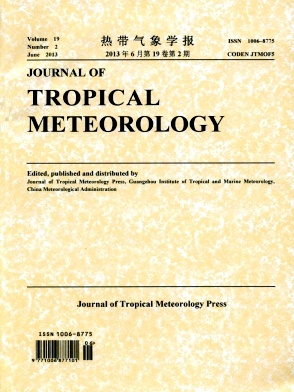|
[1]
|
MASON B J. Physics of clouds [M]. Institute ofAtmospheric Physics (IAP) of the Chinese Academy ofSciences (CAS), Beijing: Science Press, 1978: 504-584(Translation). |
|
[2]
|
ZHOU Xiu-ji, TAO Shan-chang. YAO Ke-ya. AdvancedAtmospheric Physics [M]. Beijing: China Meteorological Press,1991: 535-602. |
|
[3]
|
LI Jian-hua, GUO Xue-liang, XIAO Wen-an. Relationshipof cloud-ground lightning activities with radar echo andprecipitation in storms of Beijing [J]. J. Nanjing Inst. Meteor.,2006, 29 (2): 228-234. |
|
[4]
|
CHEN Zhe-zhang. The characteristics of lightning fromclouds to ground accompanying with Hailstones, thunderstormsand gusts [J]. Acta Meteor. Sinica, 1995, 53(3): 365-374. |
|
[5]
|
LI Nan, WEI Ming, YAO Ye-qing. Analysis and mechanismstudy on the correlation between lightning and radar data insevere weather [J]. J. Trop. Meteor., 2006, 22 (3): 265-272. |
|
[6]
|
FENG Gui-li, QIE Xiu-shu, YUAN Tie, et al. Lightningactivity characteristics of hail storm and precipitation structure[J]. Earth Sci. (Ser. D), 2007, 37(1): 123-132. |
|
[7]
|
LI Zhao-rong, FU Shuang-xi, LI Bao-zi, et al. Observingstudy of lightning characteristics on hail cloud [J]. J. Trop.Meteor., 2005, 21(6): 589-596. |
|
[8]
|
CAREY L D, RUTLEDGE S A. Electrical andmulti-parameter radar observations of a severe hailstorm [J]. J.Geophys. Res., 1998, 103 (D12): 13979-14000. |
|
[9]
|
QIE X, YU Y, WANG D, et al. Characteristics ofcloud-to-ground lightning in Chinese Inland Plateau [J]. J.Meteor. Soc. Japan, 2002, 80(4): 745-754. |
|
[10]
|
LANG T J, RUTLEDGE S A, DYE J E, etal.Anomalously low negative cloud-to-ground lightning ratesin intense convective storms observed during STERAO-A [J].Mon. Wea. Rev., 2000, 128: 160-173. |
|
[11]
|
SOULA S, SEITY Y, FERAL L, et al. Cloud-to-groundlightning activity in hail-bearing storms [J]. J. Geophys. Res.,2004, 109, D02101, doi: 10.1029/2003JD003669. |
|
[12]
|
ZHOU Jun-jun, QIE Xiu-shu, ZHANG Yi-jun, et al. Therelationship between cloud to ground lightning andprecipitation in the convective weather [J]. Acta Meteor. Sinica,1999, 57(1): 103-110. |
|
[13]
|
ZHANG Yi-jun, HUA Gui-yi, YAN Mu-hong. Thecorrelation analysis of electric activity, convection andprecipitation in convective cloud and stratus [J]. PlateauMeteor., 1995, 14(4): 396-405. |
|
[14]
|
LIN Kai-ping, LIN Zong-gui, YI Yan-ming, et al. Thespatial and temporal distribution for lightning of various cloudssystem [J]. J. Trop. Meteor., 2005, 21(4): 384-392. |
|
[15]
|
ZHANG Teng-fei, YIN Li-yun, XU Ying-jie, et al.Analysis of characteristics and causes of lightning activity inMay to August of 2007 in Yunnan [J]. J. Catastroph., 2009,24(1): 73-79. |
|
[16]
|
ZHANG Teng-fei, LU Ya-bin, PU Gui-ming. Mesoscaleanalysis of a Yunnan severe precipitation event arose fromlow-vortex shear [J]. Meteor. Mon., 2003, 29(12): 29-33. |
|
[17]
|
LI Ying, GUO Rong-fen, SUO Miao-qing, et al.Elementary study on northward movement of convective cloudcluster over the Bay of Bengal to the Low Latitude Plateauduring early summer [J]. J. Trop. Meteor., 2003, 19(3):277-284. |
|
[18]
|
ZHANG Teng-fei, DUAN Xu, ZHANG Jie. Mesoscaleanalysis of Yunnan successive heavy precipitation caused bystorms over the Bay of Bengal in the early summer [J]. J. Trop.Meteor., 2006, 22(1): 67-73. |
|
[19]
|
WANG Xiao-ming, XIE Jing-fang, WANG Fei. Severeconvective weather analysis and short-term forecasting [M].Beijing: China Meteorological Press, 1992. |
|
[20]
|
ZHANG Teng-fei, ZHANG Jie, GUO Rong-fen. Dopplerradar echo feature and environmental condition analysis of amesoscale rain belt [J]. J. Appl. Meteor. Sci., 2005, 16(1):70-77. |
|
[21]
|
CHEN Wei-min. Principles of Lightning [M]. Beijing:China Meteorological Press, 2006: 112-149. |

















 粤公网安备 4401069904700002号
粤公网安备 4401069904700002号
 DownLoad:
DownLoad: